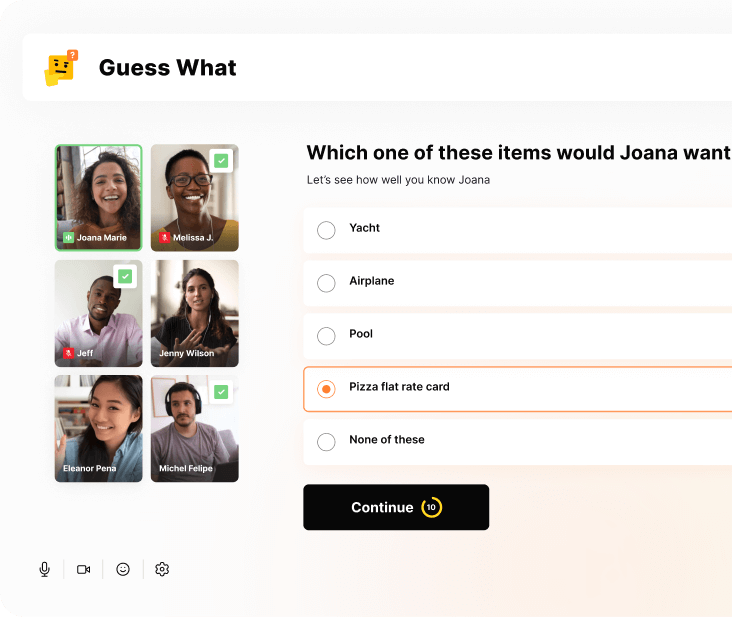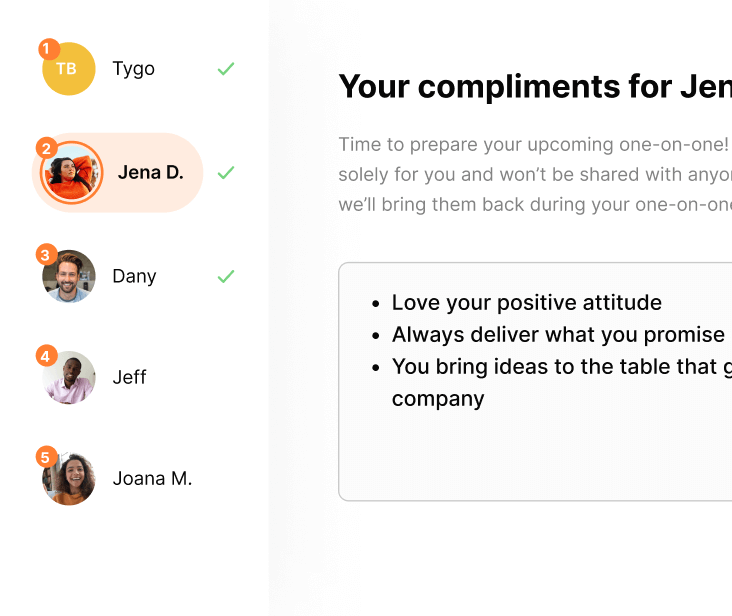Back to Blog
How to spot and work with disengaged employees: a guide
You’ve been having issues for a while with one of your employees. At first, you try your best management strategies, but you’re starting to suspect an issue with employee engagement.
It’s possible that your employee has disengaged from your work. That’s not great news, but maybe it is in the early stages still.
When you identify behaviors of a disengaged employee, seek more information and start making changes. Here’s what to look for and why it matters that you address it.
Related: 2023 virtual team building activities to engage your team.
What is a disengaged employee?
Because Gallup defines employee engagement as involvement and enthusiasm in the workplace, disengaged employees are those who aren’t involved and show a lack of enthusiasm. They aren’t motivated to work or responding to typical incentives and drawbacks.
Disengagement can vary depending on how far along they are in disengagement. The way your employee reduced their level of engagement matters for how you improve the situation.
Share fun facts and bond with a team quiz
Have your participants choose from a list of questions they’d like their coworkers to answer about them, before watching as they guess the right answer.
01. Yes
share-fun-facts-and-bond-with-a-team-quiz

Run a guided recognition activity
Have your participants choose from a list of questions they’d like their coworkers to answer about them, before watching as they guess the right answer.
01. Yes
run-a-guided-recognition-activity

Organize a virtual cooking class
Hire a professional chef to help your team cook a delicious lunch or dinner. May be difficult for co-workers with families. To find providers and get tips, read our blog about virtual cooking classes.
02. No
organize-a-virtual-cooking-class

Hire a stand-up comedian
Have your participants choose from a list of questions they’d like their coworkers to answer about them, before watching as they guess the right answer.
02. No
hire-a-stand-up-comedian

No items found
No items found
Table of contents
You’ve been having issues for a while with one of your employees. At first, you try your best management strategies, but you’re starting to suspect an issue with employee engagement.
It’s possible that your employee has disengaged from your work. That’s not great news, but maybe it is in the early stages still.
When you identify behaviors of a disengaged employee, seek more information and start making changes. Here’s what to look for and why it matters that you address it.
Related: 2023 virtual team building activities to engage your team.
What is a disengaged employee?
Because Gallup defines employee engagement as involvement and enthusiasm in the workplace, disengaged employees are those who aren’t involved and show a lack of enthusiasm. They aren’t motivated to work or responding to typical incentives and drawbacks.
Disengagement can vary depending on how far along they are in disengagement. The way your employee reduced their level of engagement matters for how you improve the situation.
7 behaviors and habits of disengaged employees
Often, you’ll see disengaged employee behaviors on a regular basis, rather than just a bad day here or there. In most cases, disengagement begins with a change in behavior. This can be a slow change or a sudden one. In other cases, an employee may be under-engaged from the moment their hired at your company.
Watch out for these seven habits of highly disengaged employees so you can decisively intervene.
1. Low communication
Employees who stop responding promptly to chats and emails, who speak in short, low-information sentences, or who skip meetings can all be reducing their communication due to disengagement.
Is your employee is speaking up substantially less than they used to? Are they simply not meeting the communication requirements for getting the job done? Think how you can model strong workplace communication and your expectations.
2. A change in effort or output
Disengaged employees often show a reduction in how hard they are working or how much they achieve.
Things like asking for deadlines to be pushed back, work returned to be done over, and negative feedback from other stakeholders can all indicate low effort or output.
Because other factors can affect effort and output, the first step is to have an honest conversation with the team member. You can ask if there are obstacles you can remove or if there’s a deeper issue that can be identified.
3. Complaining rather than problem-solving
Negativity in the workplace tends to stand out, even at companies with low employee engagement. Rather than letting yourself react in the moment, take note when employees are just focusing on the bad in a public or even private meeting setting without any attempt to solve the problem.
You can spot negativity when it happens in front of you, but another good move is to ask fellow team members if they’ve seen an attitude shift. Often, just asking for the facts can help you bring to light complaining that didn’t reach a manager.
Complaining comes from an honest place, but it’s not always constructive. Try to have a one-on-one with your complaining team member and ask if there’s anything in particular that makes them feel they aren’t being heard. Then ask directly how such problems could or should be solved.
4. Low quality work without acknowledgement
Engaged employees sometimes have challenges in their health or personal life that create a dip in the quality of their work. However, work that is not good when the employee doesn’t have a clear reason for it can be a sign of disengagement.
When someone is technically checking off to-do list items, it can sometimes be difficult to notice quickly that the work’s quality is dropping. You can keep your eye on this by asking people who see the work most closely, such as a team member who receives their work for the next step in a process, whether they’ve noticed a change.
5. Zoned-out or literally out to lunch
Not paying attention in meetings or conversations is a tell-tale sign of disengagement. Even companies that don’t track absences rigidly benefit from a way to know when employees are and aren’t working. If an employee is suddenly absent without explanation, you want to have a way to catch it and have a conversation about it.
If a conversation about absences doesn’t lead to a proactive change, it can be worthwhile to reiterate the expectations of the job. If the employee is not meeting objectives at work, you can work with them to make the connection that being zoned-out or absent is having a major impact on their performance.
6. Less initiative
A more subtle sign of disengagement is seen when a high performer retreats from their top performance to a “doing only what’s asked of me” attitude. Do you have a team member who used to proactively solve problems and create new ideas? Pay attention if they suddenly stop doing so.
A kind conversation about the high quality of that employee’s ideas can often inspire them to bring more initiative next time. Encouragement and recognition in the workplace are excellent invitations for team members to re-engage.
7. They are actually leaving your company
It’s pretty clear when an employee is literally disengaging from your workplace. Most employees who are quitting will cite the strength of their next opportunity in order to soften the perception that they are leaving because they no longer like your company.
Use surveys and exit interviews with every departing employee, even those that you were sure were highly engaged. The data you gather may help you identify ways and reasons why other employees could be leaving next so that you can make changes.
Creating retention initiatives can be as simple as recognizing that your pay and benefits are out of alignment with the market, or as complex as training to become a stronger management team. Either way, use your departing employees’ insight to become more effective.
How to deal with disengaged employees as a manager
There are often multiple reasons why employees are disengaged, and as a manager, you can work through each of them in turn. It’ll be easier with resources on how to improve employee satisfaction overall, and here’s an outline of how you can get started.
- Measure: Using a combination of quick pulse surveys and longer semi-annual surveys, establish a baseline for how employees feel about different aspects of their work. Tracking the results lets you correlate drops in employee engagement with particular changes in the work or management.
- Understand the theory behind engagement: Many people have studied employee engagement’s benefits, creating models that help employers craft new policies. Learning the theory underpinning employee engagement and the levels of engagement that are possible can help you confidently make next steps.
- Use technology like Gomada to take work off your plate: A variety of apps, engagement platforms, and software have been designed to make engagement more effective, easier to track, and more intuitive during your busy day as a manager.
- Learn from companies that are getting it right: Tracking companies that rank highly on employee engagement can teach you a lot about what could cure disengagement at your company.
The impact of disengaged employees
Disengaged employees interact with colleagues and customers. This can
- Reduce the satisfaction that colleagues take in their own jobs.
- Create a negative impression on customers about how the company treats employees.
- Drive down sales/customer engagement, undoing the work of the company
It’s time to address the signs of disengagement in your employees. Work can be better and more impactful for everyone when you find the root causes and make some changes.
Subscribe to get our latest updates
Subscribe to get our latest updates
.webp)



.jpg)

.jpg)